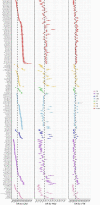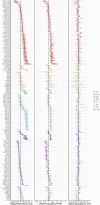This is a preprint.
Integrative metabolomics differentiate coronary artery disease, peripheral artery disease, and venous thromboembolism risks
- PMID: 37425786
- PMCID: PMC10327201
- DOI: 10.1101/2023.06.21.23291103
Integrative metabolomics differentiate coronary artery disease, peripheral artery disease, and venous thromboembolism risks
Update in
-
Integrative Metabolomics Differentiate Coronary Artery Disease, Peripheral Artery Disease, and Venous Thromboembolism Risks.Arterioscler Thromb Vasc Biol. 2024 Sep;44(9):2108-2117. doi: 10.1161/ATVBAHA.124.321282. Epub 2024 Jul 25. Arterioscler Thromb Vasc Biol. 2024. PMID: 39051123 Free PMC article.
Abstract
Rationale: Arterial and venous cardiovascular conditions, such as coronary artery disease (CAD), peripheral artery disease (PAD), and venous thromboembolism (VTE), are genetically correlated. Interrogating distinct and overlapping mechanisms may shed new light on disease mechanisms.
Objective: In this study, we aimed to: identify and compare (1) epidemiologic and (2) causal, genetic relationships between metabolites and CAD, PAD, and VTE.
Methods: We used metabolomic data from 95,402 individuals in the UK Biobank, excluding individuals with prevalent cardiovascular disease. Logistic regression models adjusted for age, sex, genotyping array, first five principal components of ancestry, and statin use estimated the epidemiologic associations of 249 metabolites with incident CAD, PAD, or VTE. Bidirectional two-sample Mendelian randomization (MR) estimated the causal effects between metabolites and cardiovascular phenotypes using genome-wide association summary statistics for metabolites (N = 118,466 from UK Biobank), CAD (N = 184,305 from CARDIoGRAMplusC4D 2015), PAD (N = 243,060 from Million Veterans Project) and VTE (N = 650,119 from Million Veterans Project). Multivariable MR (MVMR) was performed in subsequent analyses.
Results: We found that 194, 111, and 69 metabolites were epidemiologically associated (P < 0.001) with CAD, PAD, and VTE, respectively. Metabolomic profiles exhibited variable similarity between disease pairs: CAD and PAD (N = 100 shared associations, R2 = 0.499), CAD and VTE (N = 68, R2 = 0.455), and PAD and VTE (N = 54, R2 = 0.752). MR revealed 28 metabolites that increased risk for both CAD and PAD and 2 metabolites that increased risk for CAD but decreased risk for VTE. Despite strong epidemiologic overlap, no metabolites had a shared genetic relationship between PAD and VTE. MVMR revealed several metabolites with shared causal effects on CAD and PAD related to cholesterol content within very-low-density lipoprotein particles.
Conclusions: While common arterial and venous conditions are associated with overlapping metabolomic profiles, MR prioritized the role of remnant cholesterol in arterial diseases but not venous thrombosis.
Figures





References
Publication types
Grants and funding
LinkOut - more resources
Full Text Sources
Miscellaneous
